What’s What at the Latest DEMA ShowContents of this Issue: Villa on Dunbar Rock, Guanaja, Honduras Shearwater Recalls Its Computer Transmitters Save Money on Baggage. Fees: Pack with a Purpose Another Good Story about that Epic Thai Cave Dive Rescue Random Thoughts on Dive Travel Glitches A Diver Boosts the #MeToo Movement in Egypt Why Are Red Sea Sharks Biting More Often? What’s What at the Latest DEMA Show Big Trouble at Blue Heron Bridge “I Very Quickly Realized It Was a Crocodile” Dumping Lead Down the Toilet Gets a $197,000 Fine Readers Have Their Say about Our Review of Sunset House No Abalone Diving in California Until at Least 2021 Confused about Lithium Batteries? Editorial Office: Ben Davison Publisher and Editor Undercurrent 3020 Bridgeway, Suite 102 Sausalito, CA 94965 and do you really need to buy anything they’re selling? from the January, 2019 issue of Undercurrent
How much dive gear do you really need? Jacques Cousteau's divers made do with mask, fins, a regulator and a tank or two on their backs. We add stuff to make it a better experience, but it could be said that more stuff sometimes overcomplicates matters. So what new equipment appeared at the annual Diving Equipment Manufacturers Association (DEMA) show? And does any of it really matter? Only a small proportion of the exhibitors who showed at this year's show, held in Las Vegas last November, were diving equipment manufacturers, and new products scheduled to be sold this year tend to be examples of gentle evolution rather than anything truly revolutionary. The DEMA show has instead evolved into what is mainly a dive travel exhibition, along with the photo equipment needed to record any encounters on those travels. Dive resorts from every corner of the planet competed to attract visitors from among the dive professionals who attended. Even the Italian manufacturer, Cressi, now promotes a Galapagos liveaboard, the Galapagos Evolution. It was also noticeable that fewer of the big-name personalities in diving were seen strolling the aisles, than in previous years. Maybe it's because they're all getting older -- like the rest of us. What's New in Dive Equipment?
Regarding lighting equipment, advanced battery technology, combined with even more efficient LEDs, continues to make video lights smaller and better performers. The Weefine 3000 and Kraken 3000 are both interesting LED ring-lights that can substitute for a strobe by emitting an intense burst of 3000 lumen light that's triggered by the camera's on-board strobe and are useful for extreme close-up pictures. Although that makes it less able to capture fast action due to the longer duration of the pulse of light, it does mean the "modeling light" accurately represents the final flash, making things easier for the photographer (www.krakensports.ca). Underwater photographers, who were limited to two or three manufacturers of conventional strobes in the past, can now enjoy a plethora of choice. New strobes were represented, among others, by iDiveSite and its Simbiosis SS-03, a less bulky offering than previous models but still combining a strobe with a 2800 lumen video light for those who like to switch between stills and video during a dive (www.i-divesite.com). Italian manufacturer One UW announced an entirely new strobe, the One160X, a welcome addition to an otherwise limited range of underwater strobes (www.oneuw.com). Retra is a new kid on the block that hopes to start shipping its updated new model, with built-in leak detector, next summer (www.retra-uwt.com).
Scared of flooding your camera? Rare only a decade ago, vacuum leak tests are now common on more expensive housings, and even the less expensive Seafrogs housing can be fitted with such an accessory. With M16 and M14 adapters, it can fit other makes of housing, too (www.seafrogs.com.hk). 10Bar does something similar. And the Weefine iPhone housing has a similar system that confirms you've assembled your housing without the risk of a leak -- and a catastrophic loss of your iPhone data (www.weefine.com). Some products have been further developed since the past year's DEMA. For example, last year we mentioned the Reg-Mount, which puts your POV camera ahead of your exhaled bubbles. This year, it has come back with alternative fittings for different regulators, alternative points for mounting your GoPro, and even a light -- although that can clutter the diver's view (www.regmount.com). The Most Innovative Gear The most innovative diving-focused product could be found at the Atomics Aquatics section of the Huish Outdoors booth -- and it's so simple, I can't believe nobody thought of it before. Open a tank valve at the surface and you'll spot how cold the air from it is. When the air from your tank is depressurized, as it is by your regulator, it expands and loses a lot of heat -- it's your lungs that warm up that cold air. No matter how warm the water is, you'll eventually get chilled, increasing your air consumption and cutting short your dive. Scuba Heat is a coil of copper nickel alloy that sits in your air supply, between the first- and second-stages of the regulator, and exchanges heat with the surrounding water to make it approach ambient water temperature, and thereby make it more comfortable to breathe. Scuba Heat is expected to cost around $350. That sounds pricey, but hey, at what price comfort? And don't think this is solely for cold water divers. No doubt there will be some similar copper-coiled pipes coming from China, if the idea catches on -- and those will inevitably cost less than a hundred bucks (www.atomicaquatics.com). When it comes to cold water diving, one way to go is to wear a heated vest, and FIXNeo provided such a thing, safe enough to go under a wetsuit if required. Even tropical waters suck heat from your body, so these new heated vests could be a good application in conjunction with a lightweight wetsuit (www.fixneo.com).
As we get older, we usually need our reading glasses for extreme close-ups of underwater critters. But if you need a minus-diopter prescription in your mask, that presents a problem to fitting both sets of lenses. The 10Bar has come up with Mask MF Flip Frame, a mask that allows the user to flip down the "reading glasses," so to speak, which can be combined with a bright, mask-mounted LED. That's a solution for those who don't readily take to the bifocal solution offered by other mask manufacturers (www.10bar.com). Packing a large pair of fins is problematic for traveling divers. Seac exhibited a new range of compact fins as a solution, although they're probably less effective for propulsion in the water (www.seacsub.com). With so much black gear around, it's a joy to see new brightly colored silicone masks from the likes of Seac, Scubapro and Oceanic, and technopolymer fins like the Apeks RK3 (www.apeksdiving.com). Aqua Lung has a range of colorful covers for its Rogue wing-style BCs. The Latest in Tech Gadgets Some computers are also available in bright colors now, including entry-level models like the Aqua Lung i200c and Italian manufacturer Ratio, offering full-color displays on its Ratio Easy Dive (www.ratio-computers.com). Monochromatic displays on dive computers are looking a little dated, especially on more advanced ones. The display on the Aqua Lung i770R is both colorful and links directly to a smartphone for both setting up and downloading (www.aqualung.com).
The D5 is probably Suunto's direct response to the threat posed by the superficially similar and also extremely elegant Shearwater Teric (www.shearwater.com). The Italian company, Mares, introduced its Mares Genius computer. Mares' chief technology officer, Sergio Angelini, is a mathematical geek, and he gave me a rundown of all the parameters that can be entered to personalize it -- and a headache trying to keep up with him. If you want the full nine yards, you can get it in an article by Angelini at Underwater Technology (https://issuu.com/sut7/docs/underwater_technology_35.2; www.mares.com) The French whiz kids at Thalatoo showed the Maoi, a new computer concept that debuted last year -- it mounts on your mask and promises a head-up display. Thalatoo is still looking to get it to market, so there is still a question about whether it will ever be available to buy (www.thalatoo.com). The same might be said of the French Serenity S1 Frioul. It's a dive computer that works in conjunction with a beacon to help you navigate back to the boat. The three-item kit also allows those on the boat to monitor the various positions of several divers in the water, giving an extra degree of safety (www.serenityconcept.com). The even more clever people at Ariadna Tech in Finland displayed the Posio dive computer that, by means of a separate unit strapped to your leg, can learn your fin strokes and then, in conjunction with surface GPS, show a 3D route you can take on your dives, effectively bringing GPSstyle navigation to your dives. That leg-mounted sensor uses your swimming motion to build a real-time picture of where you are in the water. Is the Posio Diver Positioning System an example of more technology than we really need? (www.ariadna.tech) The Miscellaneous Every DEMA show offers a hopeful entrepreneur attempting to break into the dive market, and the inventor of the Aqua Sketch Tablet was no exception this year. He showed a frame that uses waterproof paper so that divers can take their own pre-prepared dive notes, printed at home on standard-size paper, underwater with them (www.aquaSketch.com).
Ocean Technology Systems showed its Spectrum full-face diving mask, into which you can fit your regulator's second stage. The idea is that it keeps the face warm and dry, eliminates jaw fatigue and prevents exposure to nasty water-based pathogens (www.oceantechnologysystems.com). Among products that were a little hair-raising, the Easy Dive Snorkelator comes from the company that makes Spare Air. It combines a snorkel with a switchable Spare Air cylinder for those who want to snorkel and swim down from the surface. No mention of pneumothorax or emphysema, though, because what could possibly go wrong? (www.spareair.com)
For those of us who get a little weary when swimming any distance, there were, as usual, plenty of motor-driven aids available, including the armmounted Scubajet, a refined development of something we first saw at last year's DEMA show (www.scubajet.com). The SUBlue compact DPV is good for 30 minutes of in-water use before recharging (www.sublue.com). If you're getting too tired to bother with the effort of actually diving and you have at least $4,000 or more to spare, you can dive vicariously with a remote-controlled ROV such as the Deep Trekker (maximum operating depth ranges from 164 to 500 feet, depending on the model), which had its fine control and maneuverability features demonstrated in a clear acrylic tank for all to see (www.deeptrekker.com). Stream2Sea showed a range of sunscreens, shampoos and sting-relief products that claimed to be kind to coral reefs and their ecosystems. There was no sign of its rival, Reef Safe, and its oxybenzone-based products on display, which we denounced in the August 2018 issue of Undercurrent (www.stream2sea.com). Finally, some excellent news from Fourth Element, a small but rapidly growing eco-conscious British company, which introduced its prototype Surface wetsuit made from recycled content. Its "Ocean Positive" lining is made up of 95 percent material from recovered plastic bottles. Barring any production problems, expect it to be on sale soon (www.fourthelement.com). -- John Bantin |

I want to get all the stories! Tell me how I can become an Undercurrent Online Member and get online access to all the articles of Undercurrent as well as thousands of first hand reports on dive operations world-wide
| Home | Online Members Area | My Account |
Login
|
Join
|
| Travel Index |
Dive Resort & Liveaboard Reviews
|
Featured Reports
|
Recent
Issues
|
Back Issues
|
|
Dive Gear
Index
|
Health/Safety Index
|
Environment & Misc.
Index
|
Seasonal Planner
|
Blogs
|
Free Articles
|
Book Picks
|
News
|
|
Special Offers
|
RSS
|
FAQ
|
About Us
|
Contact Us
|
Links
|
3020 Bridgeway, Ste 102, Sausalito, Ca 94965
All rights reserved.

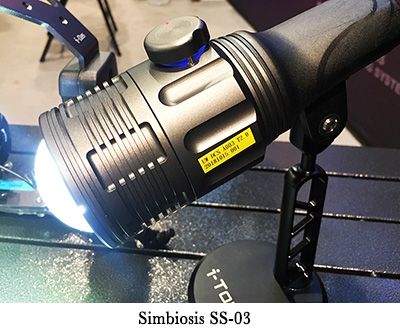 Technical diving and underwater photography
have been the biggest growth areas in recent years,
but when, not so long ago, it seemed nearly every
equipment manufacturer showed a hopeful prototype
of a closed-circuit rebreather, there are now
just a mere handful of manufacturers with a core of
properly developed models. The semi-closed models
intended for the less-serious recreational diving
market appear to have fallen by the wayside. So that leaves gathering images while underwater.
Manufacturers of housings often just tweak their
products to cater for new cameras. Nauticam stands
alone in that it is developing optics for use in water
with the Nauticam MWL-1 supplementary lens,
which, combined with a camera's prime macro, is
intended for close-focus, wide-angle use. That lets
a DSLR user swap between the two while underwater,
just as a user of a compact camera with wet
lenses could. Only time will tell whether the image
quality will be good enough, but with such images
now being mainly reproduced online, it's probably
less important than it was (
Technical diving and underwater photography
have been the biggest growth areas in recent years,
but when, not so long ago, it seemed nearly every
equipment manufacturer showed a hopeful prototype
of a closed-circuit rebreather, there are now
just a mere handful of manufacturers with a core of
properly developed models. The semi-closed models
intended for the less-serious recreational diving
market appear to have fallen by the wayside. So that leaves gathering images while underwater.
Manufacturers of housings often just tweak their
products to cater for new cameras. Nauticam stands
alone in that it is developing optics for use in water
with the Nauticam MWL-1 supplementary lens,
which, combined with a camera's prime macro, is
intended for close-focus, wide-angle use. That lets
a DSLR user swap between the two while underwater,
just as a user of a compact camera with wet
lenses could. Only time will tell whether the image
quality will be good enough, but with such images
now being mainly reproduced online, it's probably
less important than it was (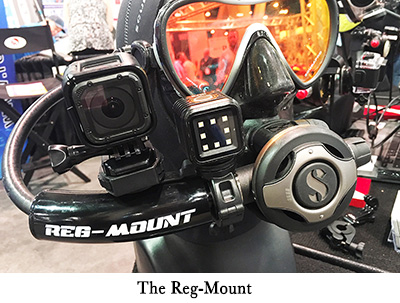 Well-established Inon continues to be promoted
by its CEO merely carrying a bag full of equipment
around the trade floor and demonstrating to interested
parties in the refreshment areas, thereby saving
on the cost of a booth. He's been doing that for years,
and nobody from DEMA appears to have challenged
him (
Well-established Inon continues to be promoted
by its CEO merely carrying a bag full of equipment
around the trade floor and demonstrating to interested
parties in the refreshment areas, thereby saving
on the cost of a booth. He's been doing that for years,
and nobody from DEMA appears to have challenged
him (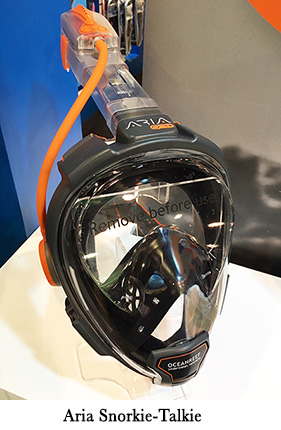 Full-face snorkeling masks may have been
banned in Hawaii, thanks to a number of dive fatalities
by those who were using them, but competition
in this sector is still fierce. The Cressi Duke takes on
its Italian neighbor and rival, Ocean Reef, which is
the market leader with its Aria. With an improved
design that has the snorkel pipe set to one side
in an effort to combat buildup of carbon dioxide,
the Cressi Duke also includes better education on
how to use it safely (
Full-face snorkeling masks may have been
banned in Hawaii, thanks to a number of dive fatalities
by those who were using them, but competition
in this sector is still fierce. The Cressi Duke takes on
its Italian neighbor and rival, Ocean Reef, which is
the market leader with its Aria. With an improved
design that has the snorkel pipe set to one side
in an effort to combat buildup of carbon dioxide,
the Cressi Duke also includes better education on
how to use it safely (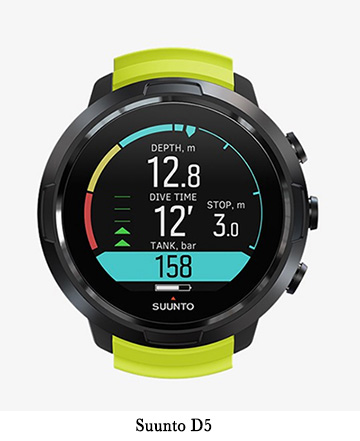 The Suunto D5 is an elegant watch-style computer
with a very clear full-color display, and, in a
break with Suunto tradition, its battery is rechargeable.
Designed to go down to 330 feet, it can be
paired with
a transmitter
to display
tank
pressure
and remaining
air time.
It also has
Bluetooth
connectivity
with smartphones
and
comes with
a choice
of brightly
colored silicone
straps
The Suunto D5 is an elegant watch-style computer
with a very clear full-color display, and, in a
break with Suunto tradition, its battery is rechargeable.
Designed to go down to 330 feet, it can be
paired with
a transmitter
to display
tank
pressure
and remaining
air time.
It also has
Bluetooth
connectivity
with smartphones
and
comes with
a choice
of brightly
colored silicone
straps
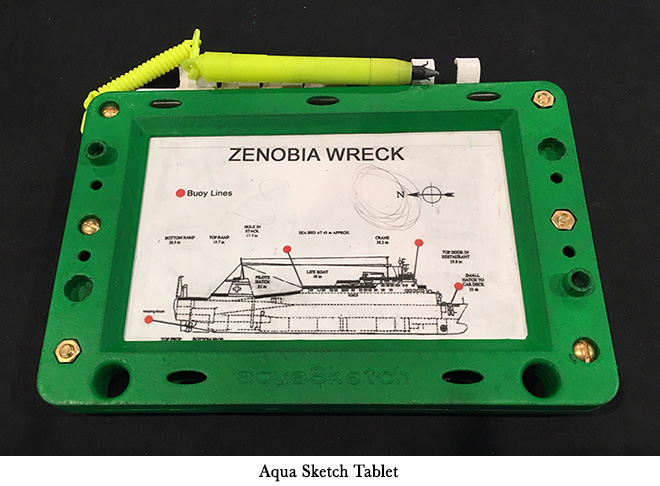
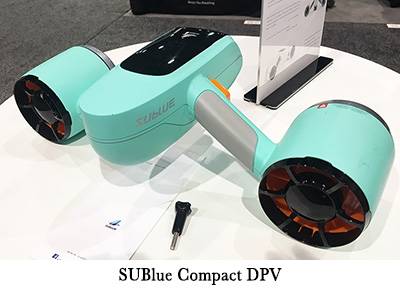 Those who want the best will want gear made
out of titanium, a lightweight and durable metal,
but it comes at a pretty penny. All-titanium regulators
have been the province of Atomic Aquatics up
to now, so it's ironic that the man who designed that
company's original item created the original design
on which the Scubapro titanium Mk25T Evo S620Ti is based (
Those who want the best will want gear made
out of titanium, a lightweight and durable metal,
but it comes at a pretty penny. All-titanium regulators
have been the province of Atomic Aquatics up
to now, so it's ironic that the man who designed that
company's original item created the original design
on which the Scubapro titanium Mk25T Evo S620Ti is based (